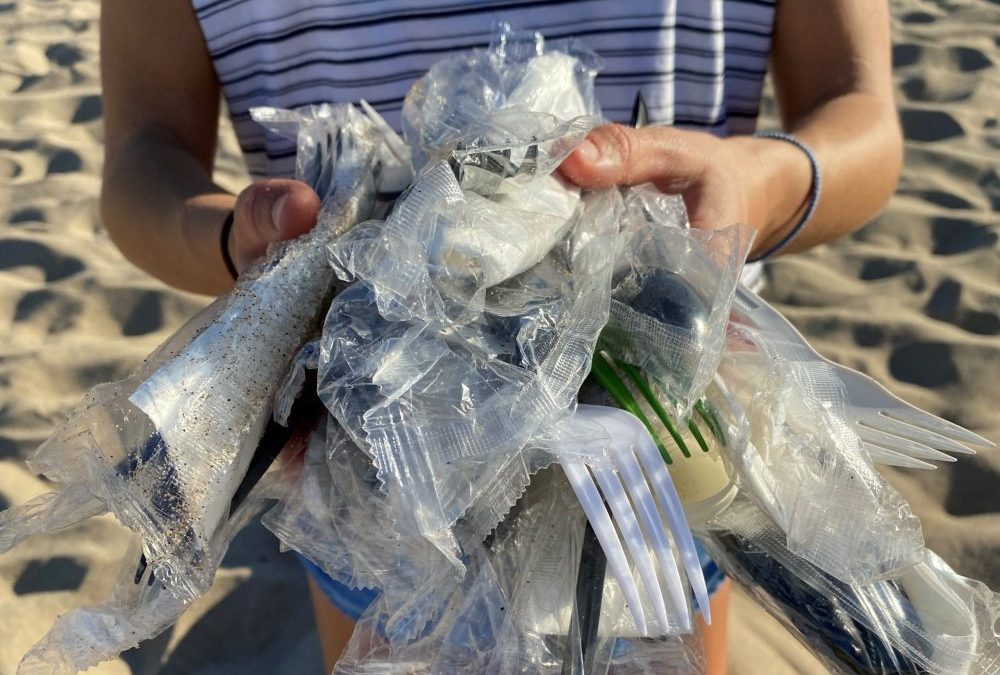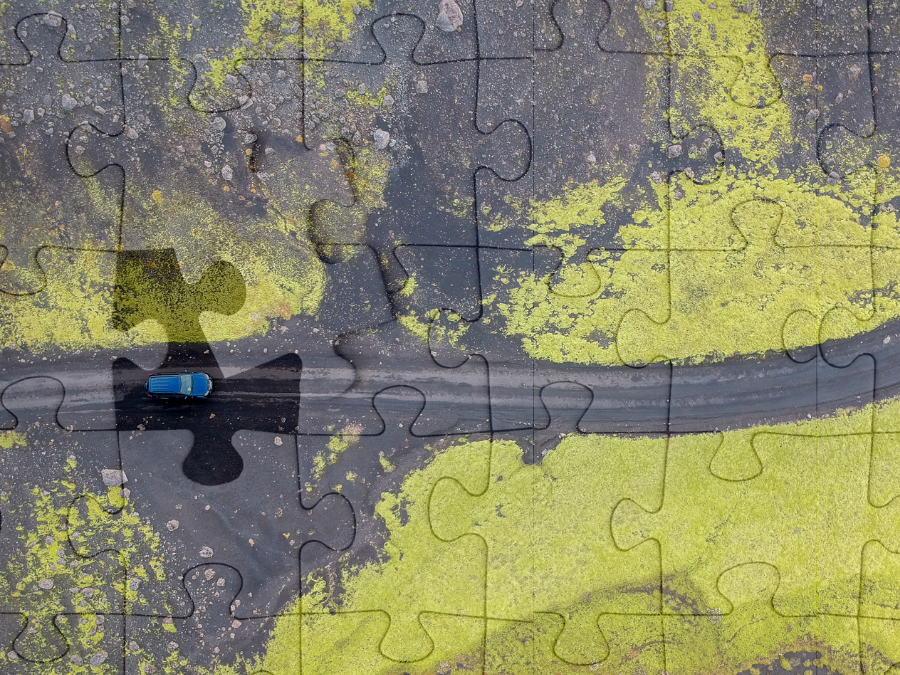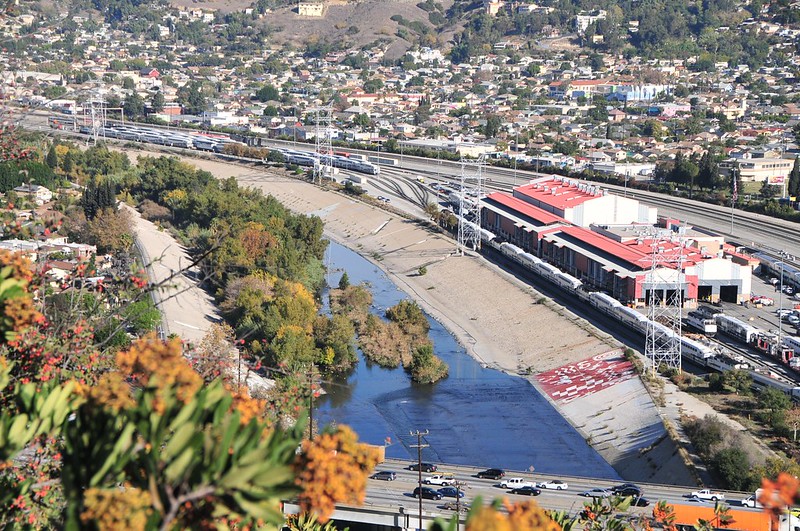
by SCLA | Apr 19, 2021 | Explainers, Newsletters
By Anna Schniepp
If you have ever spent time in the Zero Waste space on the internet, you may have come across perfectly curated minimalist kitchens with no plastic in sight. The reality, however, is that this goal is unrealistic for most people. Not everyone has access to bulk stores, farmers markets and specialty shops that offer plastic-free goods. Moreover, these beautiful zero waste households ignore the fact that the problem is not consumers who have little to no say how their products are packaged, but the companies that continue to prioritize plastic packaging. So, what can we do?
Consider a Trash Audit: If you’re a fan of the outdoors, it’s not an uncommon sight to see wrappers, bottles, tissues and more littering everything from neighborhood parks to remote mountain vistas. When you visit an outdoor space, consider bringing a trash bag and collecting stray trash (and remember to dispose of your own trash correctly!) and take it to the next level with a trash audit. Keep track of frequently spotted brands when picking up trash and email those companies about their contributions to the ongoing waste problems.
Contact Brands You Love: Is there a particular product that you love but it bugs you that it comes in plastic? Email the company and let them know your thoughts! Caving to consumer pressure, many brands are beginning to offer plastic free alternatives as it becomes clear that it is a priority for their customers. Commit to sending one or two emails a month and encourage your friends to join in!
Support Legislation: Keep an eye out for upcoming proposals that focus on reducing our reliance on plastics. Here in Los Angeles, the “Skip the Stuff” policy to prevent unwanted plastic utensils being added to take-out orders has been approved by the City. Keep the momentum up by contacting your representatives to thank them for supporting the motion! And on a federal level, let your representatives know that you support policies like the Break Free From Plastic Pollution Act.
Above everything, be kind to yourself. Unless you are a billionaire with a fleet of private jets, a mega mansion, or a multinational corporation that actively contributes to harming the planet, you are not the problem. Most of the damage being done to our planet is not the result of that steak you ate for dinner last week or that bottled water you bought because you forgot to bring your reusables, but the economic systems in place that prioritize cheap, unsustainable practices. Keep making changes on an individual level and this Earth Day join us in considering ways to make our low waste, plastic-free journeys a catalyst for positive changes in our communities and our world.

by SCLA | Apr 19, 2021 | Explainers, Newsletters
By Aaron Small
Our family finished a lot of puzzles to pass the pandemic time. The first rule? Start with the edges to give the puzzle its structure and shape.
If solving environmental issues on Earth Day was a 10,000 piece puzzle, you’d likely find sustainable transportation and the future of mobility along its edges. These two key elements are the backbone and solution to a myriad of challenges we face as a planet.
This year, the Biden Administration has ambitious plans around infrastructure. Like Lyndon Johnson’s sweeping reforms in the 1960s (Clean Air Act, Civil Rights Act) and FDR’s New Deal, we shouldn’t shy away from big ideas to restore balance and make an impact.
So how do we do it?
The first step would be to rethink how we get around. Internal combustion engines are quickly becoming relics of a polluted past. While electric vehicles show promise with near-zero emissions, they are not our silver bullet to solve climate change and transportation problems. EVs are still cars. Cars bring congestion and traffic violence. And the clock is ticking. We can’t replace internal combustion cars with electric cars fast enough to make enough of a difference.
In Los Angeles County, two-thirds of all travel is less than five miles. Bikes, scooting, and walking are far better options than taking a car for most short trips. That means digging the bike out of the garage and braving the streets for a spin.
Easier said than done.
To usher in a cleaner world where bikes are the go-to option, we need a safer and dependable infrastructure to allow that world to thrive. We need mobility lanes, bus lanes, and public transportation that’s efficient and reliable.
We need neighborhood streets to be places where kids can play and people can stroll – not highways where humans live in fear of getting struck by cars.
We need to make e-bikes more affordable. Electric bikes make getting around by bike accessible to many, but they’re too pricey to be popular. Big moves need to be made: rebates and subsidies – like those the government provides to prop up the EV industry – are necessary. E-bikes may be the most significant and smartest bet we can make as a society.
We need to rethink parking. America is a car country, but the world is changing, and America must change with it. With the boom of micro-mobility options and ride-sharing apps, people are driving less. With fewer cars, we need fewer parking spaces. The astonishing amount of concrete devoted to cars is absurd; with our current housing and climate crisis, we simply don’t have the space for all that empty space.
Just imagine a world with less parking. Neighborhood parks for every corner. Protected bike lanes for our children. Pedestrian plazas for communities to enjoy.
Like a winter puzzle, solving these challenges requires many hours, and many hands putting in the work. But this is our planet. And it’s up to us to figure it out.
Aaron Small is a volunteer at Streets For All, a nonprofit building a transportation revolution in Los Angeles. Follow him @TheAaronSmall

by SCLA | Apr 19, 2021 | Newsletters
By Ileana Wachtel
Wildfires have become a constant in the life of most Californians; they’ve caused massive destruction to homes, lives, livelihoods and habitat, increased greenhouse gases, and negatively impacted biodiversity. The sweeping pace and colossal severity of the fires California endured in 2020 – more than 8,200 fires ravaged over 4 million acres – exacerbated by weeks of dry, hot conditions was a stark reminder of how fast climate change is accelerating and putting California at the precipice of a new era of wildfire impact.
And 2021 isn’t looking much better, given the little rainfall the state has experienced so far. According to a report in the San Francisco Chronicle, “California is barreling toward its driest and most fire-prone months,” increasing the number of fires per month. In the month of January, there were 297 wildfires, compared to 97 wildfires in January 2020.
Experts describe this as the “new normal,” where historic wildfire buffers such as 12-lane freeways now fail to stop wind-driven wildfires. The 2018 Woolsey fire jumped the 101 freeway, and the 2017 Thomas fire sped past 70 miles of fuel breaks and three major highways. The economic toll mirrors the loss of life and habitat devastation these fires cause. In 2020 the cost was over $12.079 billion, including over $10 billion in property damage and $2.079 billion in fire suppression costs.
Legislators have yet to pass a law that would prohibit building in Very High Fire Hazard Severity Zones, which numerous scientists and experts have touted as the most effective method to stop more destruction and death, particularly since approximately 95% of fires the California Department of Forestry and Fire Protection responds to are caused by humans. Alexandra Syphard, senior research scientist at the Conservation Biological Institute, and other experts told the Los Angeles Times, “to stem the escalating loss of life and property, California must curb development in high fire-hazard zones.”
State Sen. Henry Stern’s bill, SB 55, however, is poised to do just that. It would prevent housing construction (new development) in fire hazard severity zones “unless there is substantial evidence that the local agency has adopted a comprehensive, necessary, and appropriate wildfire prevention and community hardening strategy to mitigate significant risks of loss, injury, or death.”
On April 8, Governor Newsom unveiled a $536 million funding plan focused on prevention measures. Legislators have put forth several bills that also address prevention tactics, including:
SB 45 – Climate Bond – Portantino would enact the Wildfire Prevention, Safe Drinking Water, Drought Preparation, and Flood Protection Bond Act of 2022.
SB 63 – Fire Prevention – Stern would create a fire resiliency corps and give grants to help people harden their homes against wildfires.
SB 12 – Planning and Zoning – McGuire would require a city or county that contains a very high fire risk area to amend the land use element of its general plan.
AB 642 – Wildfires — Friedman would require the Director of Forestry and Fire Protection to identify areas in the state as moderate and high fire hazard severity zones.
The Sierra Club Wildland Urban Wildfire Committee focuses on addressing land use planning and other issues related to the increasing intensity and frequency of wildfires in the Wildland-Urban Interface (WUI). To that end, our committee initiated a resolution adopted by the Sierra Club on August 22, 2020, that “supports policies that prohibit new building in Very High Fire Hazard Severity Zones, consistent with established Sierra Club infill policy, to respond to increasing intensity and frequency of devastating wildfires on lives, habitat, property, infrastructure, and the environment.”
While prevention measures are effective and needed, the dangers of continuing to build in Very High Fire Hazard Severity Zones are undisputable. If we are going to stymie the destruction, death, and loss of habitat from wildfires, we must stop building in the WUI. And, there is hope: “Since we humans are the source of most fires, we are also the solution to reducing the number of costly and damaging fires,” according to UMass Amherst researchers.
Right now, every day is Earth Day and presents an opportunity to take action and push for bold, transformative legislation that both helps combat wildfires now and plants the seeds for a sustainable future. For all Sierra Club Earth Week actions, click here.
Ileana Wachtel is a member of the Sierra Club Wildland Urban Wildfire Committee, a media strategist and communications expert.

by SCLA | Apr 19, 2021 | Newsletters, Take Action
By Jason Wise
This Earth Month we have a unique opportunity to get involved in the effort to bring a new ribbon of nature, parks, and community to our area around the Los Angeles River.
The LA County Department of Public Works released a draft master plan that is set to guide development and restoration efforts along the entire 51-mile length of the River. The public is invited to send in comments, and Friends of the LA River set up an easy to use comment portal!
The concrete flood control channel that we see at the River today – running from Canoga Park in the San Fernando Valley to Long Beach and the Pacific Ocean – was once home to an entire river ecosystem of native plants and wildlife. For the Tongva/Gabrieleño/Kizh people who have called this area home for 8,000 years, this waterway was life, providing abundant resources that they protected and sustained by living in balance with Mother Earth.
Things began to change in the 1500s when European colonists arrived; more and more people moved to the area, throwing off the balance. After a devastating flood in 1938, the wild and moody LA River was paved over, destroying most of the ecosystem. But some wild remains, specifically the three distinct “soft bottom” areas of the River (Sepulveda Basin, Glendale Narrows, and the Long Beach Estuary) that couldn’t be fully paved over. Those areas provide a glimpse of a more natural past and can give us a lot of ideas for a more environmentally-friendly River future, one that balances plants and animals with the communities of people who live nearby.
We believe there are many good elements to the existing master plan, but also a number of areas for improvement. We can use this plan to bring nature and green space back to neighborhoods that were stripped of it in 1938, while also ensuring those communities aren’t displaced in the process.
Now is a great time to get involved so that the opportunity to revitalize our River, and every living thing around it, isn’t wasted!
Take a look at the draft master plan (larivermasterplan.org), check out these two articles that discuss different aspects and concerns about the plan, and then head over the Friends of the LA River comment portal and make your voice heard on this critical local environmental issue.
Jason Wise is a naturalist and outdoor educator who teaches young people about the wonders of nature and how to become advocates for the planet. He currently works for Friends of the LA River as an educator taking kids on virtual explorations of wild Southern California ecosystems

by SCLA | Apr 19, 2021 | Newsletters, Parks
By Amanda Stemen
One of the best things about the world shutting down in the last year has been that people are spending more time outdoors. In Los Angeles, this newfound appreciation for nature has also come with more difficulty finding open, uncrowded green space. But have no fear! For those of you who are looking to stay away from the crowds, either because of COVID or just wanting some peace and quiet, here are five hidden gem parks in L.A. just waiting for you to explore. Shhh, though, we don’t want everyone finding out about them.
Elyria Canyon Park
Hiking the trails of this park will make you feel as if you’ve been teleported to a magical land far from Los Angeles. Yet, its plant life is actually the native habitat of the hills of Mount Washington. While it’s mostly hiking trails, there are places to stop and picnic if you’d rather lounge around or take a break. There are also glimpses of downtown L.A., the L.A. River, and the Griffith Observatory to remind us we haven’t actually left at all; indeed, this magical space exists in the middle of a city.
Elysian Park
Elysian Park is actually one of the larger parks in Los Angeles and home to Dodger Stadium, yet it’s rarely crowded. It has many hiking trails to explore, open fields to gather with family and friends, hidden areas if you want to disappear for a bit, picnic tables, BBQs, and bathrooms – everything you need to have an adventure or chill out without having to travel a great distance. Also, the views of downtown and Dodger Stadium, especially at sunset, are unparalleled.
Lake Hollywood Park
Located in a neighborhood in the hills west of Griffith Park, this park is situated right below the Hollywood Sign, yet lacks any pretentiousness and is barely noticed, even among locals. It’s almost always empty with a large grassy space perfect for lying down and reading a book, giving your dog some exercise, or playing some outdoor games with kids or childlike adults. It’s also near Lake Hollywood Reservoir in case you want to walk, run, or bike around a body of water. (Unfortunately, you have to leave your dog at home for this one.)
South Los Angeles Wetlands Park
While there isn’t much open space to lounge about or play around in, South Los Angeles Wetlands Park is an innovative project in a historically underserved area of the city that is well worth checking out. A previous brownfield site was transformed into this park which uses urban runoff as a treatment-wetland sustaining resource. There are walking paths around the wetlands, perfect for viewing nature that has made this space its home.
Vista Hermosa Park
This park, right next to and overlooking downtown Los Angeles, has gotten more attention this past year, but is still worth visiting, especially if you’ve never been. Pretty well hidden in historic Filipinotown, this park has walking trails, streams, meadows, bunches of trees, a nature-themed playground, nearby soccer field, and an amphitheater.
Amanda Stemen is a member of the Sierra Club, as well as a licensed outdoor therapist and writer who loves to spend time in Los Angeles’ parks.





